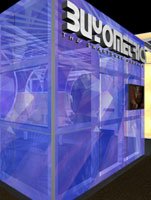Apparel Store of the Future?
Retailers get a glimpse of shopping without sales associates at GlobalShop
Welcome to the high-speed, high-concept clothing store of the future, run totally by technology, the kind of store where you might expect George Jetson to shop.
The store’s prototype, designed by Cleveland-based Herschman Architects, is scheduled to debut in Chicago at GlobalShop 2001, the annual store design and marketing trade event running March 22–24.
Herschman Architects, which won the project in a 25-firm competition, came up with a provisional concept called “buyometrics,” which includes a face scanner that recognizes the customer and will display the customer’s buying history when he or she enters the store, according to Karen Schaffner, publisher of Display & Design Ideas magazine, which is sponsoring the high-tech apparel-store prototype.
“Essentially, you can do everything from the dressing room,” Schaffner explained. “You can look at samples of the garments before you go in [to the dressing room], and then you basically push buttons and the clothing is brought to you in a pneumatic tube.”
The pneumatic tube, an update of the retro technology that once was common at department stores and banks, is visible in the prototype, “zooming around under a see-through floor,” Schaffner said. “It’s a very efficient way of delivering goods, as long as it works with the type of garment.”
Which is to say, the garment has to be constructed from a non-wrinkling fabric that can be stuffed into the canisters that travel the pneumatic-tube network. The pneumatic tubes “create kind of a whizzing, whirring effect as you watch,” Schaffner added.
The dressing rooms also will have a plasma screen and an Internet video connection, so a would-be buyer can logon, connect with a friend or family member, model the garment and get an opinion—all before making the purchase. Not surprisingly, the digital generation is expected to accept the concept faster than any other market segment, according to Schaffner.
“Then if you decide you want it, you can basically handle the transaction from the dressing room.”
And the entire shopping trip can be handled without a salesperson in sight.
“Our goal was to create a shopping space that combines the outer high-tech world and the indoor retail environment,” said Michael Fant, Herschman Architects’ design manager for the project. “We’ve stretched the barriers of the typical retail outlet by eliminating the need for sales associates.”
The purpose of the buyometrics concept, Schaffner emphasized, is not so much to get retailers to adopt it for their own future stores as it is to get them to think outside the box.
“Whether this is something you choose to pursue or you want to try something [else], try something totally different,” she urged retailers. All of the technology that will be on display at GlobalShop’s buyometric prototype is available commercially right now, Schaffner said.
Most retailers’ expansion plans are going ahead unchanged despite fears of an economic downturn, according to Shaffner. In the present environment, apparel stores that cater to Gen Y customers or to Baby Boomer women are doing particularly well, she said.
GlobalShop, to be held at Chicago’s McCormick Place, consists of five related trade shows, held together. They are the Store Fixturing Show, sponsored by the National Association of Store Fixture Manufacturers (NASFM); the Visual Merchandising Show, sponsored by the National Association of Display Industries; the Retail Operations & Construction Expo, sponsored by the Retail Contractors Association; the In-store Interactive Ideas Show, sponsored by NASFM and the Point-of-Purchase (POP) Advertising International (POPAI), and the POP Marketplace, sponsored by POPAI. This is GlobalShop’s ninth year.























